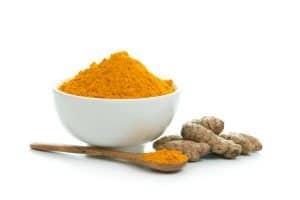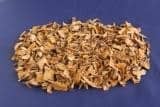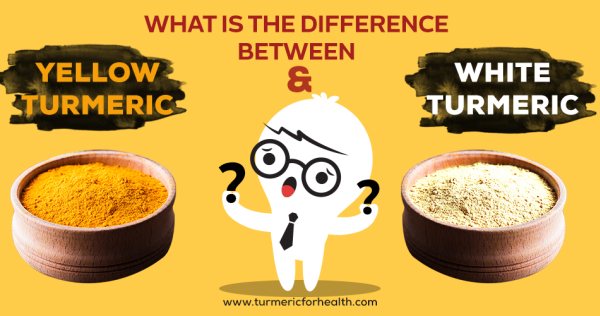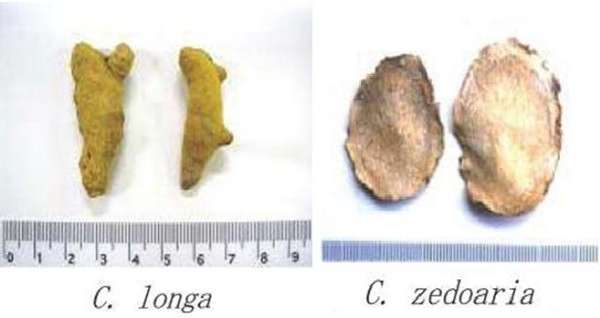Speaking of turmeric, the image that flashes in our mind is of a bright yellow or orange coloured rhizome.
Be it research or culinary use, the spotlights are generally on yellow turmeric or Curcuma longa.
Turmeric is a native spice of South-East Asia. Its use dates back to over 4000 years and is an integral part of various traditional medicine systems. Turmeric belongs to Zingiberaceae or ginger family.
Curcuma is the genus belonging Zingiberaceae and contains around 100-133 species or varieties of turmeric.
C. aromatica, C.caesia, C. zedoaria, C. comosa are few of the other important species. This article goes over Curcuma longa (yellow turmeric) and Curcuma zedoaria (white turmeric).
Table of Contents
What is Curcuma longa?
Coming back to our all time favourite – Curcuma longa which is even called Indian saffron due to its bright yellow color. India contributes to 78% of the world’s turmeric production.
Turmeric plant needs a temperature of 20 degree Celsius and adequate rainfall.
The plants grow to a height of 1m and have oblong leaves. The rhizomes are tuberous, 1-3 inches in length and 1 inch in diameter, yellowish brown on the outside and bright orange on the inside.
Composition of yellow turmeric

Curcumin accounts for 5-6.6% of the rhizome.
The volatile oil is another important component of turmeric. Volatile oil mainly contains turmerone. There are a number of other compounds such as: d-sabinene, cinol, borneol, zingiberene, germacrone, bisacurone; curcumenone; dehydrocurdione etc.
The components responsible for the aroma of turmeric are turmerone, arturmerone, and zingiberene. Turmeric is also a good source of the ω-3 fatty acid and α-linolenic acid, minerals such as calcium, phosphorous, iron, vitamin B etc.
Health benefits of yellow turmeric
Most of the research focuses on pharmacological properties of curcumin, but even turmeric oil has therapeutic value.
1. It has anti-inflammatory and painkiller property
Curcumin exerts anti-inflammatory property by interfering in the activity of nuclear factor kappa B, a protein that controls inflammation and also inhibiting the activity of inflammatory enzymes.
Even curcumin free turmeric is proven to have anti-inflammatory property. This anti-inflammatory property contributes to its painkiller property.
Derivatives of curcumin are found to have analgesic activity stronger than aspirin. A clinical trial in humans demonstrated that turmeric extracts were as effective as ibuprofen in treating knee osteoarthritis and it did not cause gastric side effects like ibuprofen.
2g of Meriva, a specialized formulation of curcumin is found to have pain relieving properties comparable to paracetamol and nimesulide and also causes lesser gastric side effects.
What does this mean?
Curcumin’s anti-inflammatory property makes it a natural alternative in reducing inflammation and as a painkiller.
2. It is an excellent antioxidant
Curcumin and other curcuminoids found in turmeric are strong antioxidants. Research shows that curcumin’s antioxidant activity is stronger than that of Vitamin C.
As an antioxidant, curcumin reduces oxidative stress (imbalance between prooxidant and antioxidant agents in body), scavenges free radical species that cause oxidative damage and raises the activity of antioxidant enzymes.
This antioxidant activity of curcumin is favourable in many diseases such as diabetes, cancer, bipolar disorder, heavy metal toxicity.
What does this mean?
Curcumin and curcuminoids have potent antioxidant activity which helps in reducing oxidative damage in diseases.
3. It is an excellent anti-microbial agent
Curcumin is a broad spectrum anti-microbial agent- it inhibits the growth of bacteria, viruses and fungi. Turmeric extracts are found to inhibit the growth of bacteria like Staphylcoccus, Streptococcus, E.coli.
It even acts against drug-resistant strains like methicillin-resistant Staph aureus.
Turmeric oil also shows bactericidal activity. Curcumin also acts in synergy with antibiotics.
Curcumin acts against many viruses such as HIV, Human Papilloma Virus, HCV and influenza.
Turmeric oil as well as curcumin show anti-fungal activity and are potent anti-Candida agents.
What does this mean?
Curcumin and turmeric oil have anti-microbial properties that inhibit growth of bacteria, viruses, fungi.
4. It is a strong anticancer agent
One of the reasons why curcumin is famous is due to its strong anti-cancer activity. Research shows that curcumin manipulates over 20 biochemical targets in the body in order to kill cancer cells. Read How Turmeric Redesigns Cancer Cell Mortality?
Curcumin can inhibit cancer growth in initial stages as a chemopreventive agent and also prevent growth of tumors as an anti-tumor agent. It sensitizes cancer cells to chemotherapy and radiotherapy as well as protects normal cells from cancer treatment damage.
Curcumin’s anti-cancer activity is found to be therapeutic in colon cancer, skin cancer, breast cancer, prostate cancer etc. (Read Turmeric for Cancer) Even components of turmeric oil, turmerone show anti-cancer activity.
What does this mean?
Curcumin found in turmeric has superior anti-cancer activity which kills cancer cells but protects normal cells. Even components of turmeric oil also show anti-cancer activity.
5. Turmeric benefits every part of the body
Turmeric has a number of other properties which aid in the treatment of various diseases.
Brain: Curcumin is found to be therapeutic in the treatment of Alzheimer’s , brain injury, depression, and anxiety, etc . It is good for brain health.
Skin: Curcumin has skin regenerative potential and wound healing properties. It finds its use in treatment of various skin disorders like scleroderma, psoriasis, skin cancer, eczema, and dermatitis.
Heart: Curcumin offers protection from heart-related diseases and is effective for recovery after a heart attack. It also helps in the treatment of atherosclerosis.
Stomach: Curcumin is therapeutic in inflammatory bowel disease, irritable bowel syndrome, gastroesophageal reflux disease and dyspepsia.
Respiratory disorders: Curcumin is beneficial in respiratory disorders like COPD, asthma etc.
What does this mean?
Curcumin’s multiple pharmacological properties make it beneficial for treating various disorders of heart, lungs, skin, stomach etc.
How to use yellow turmeric, Curcuma longa?
If you opt for dry roots the recommended dose is 1.5 to 3 g while for powdered root it is 1-3g. We recommend taking The Golden Paste.
This recipe combines the goodness of turmeric with black pepper and oils which enhance its absorption. 1-2 teaspoons once or twice a day should suffice. Turmeric Milk is a great option too.
Precaution
Turmeric in diet is safe; however, it is the supplements you should be cautious about. Turmeric supplements should be avoided in pregnancy and lactation.
Turmeric supplements should be discontinued 2 weeks prior to surgery as they might increase bleeding risk. Individuals suffering from gallbladder problems should avoid turmeric.
Turmeric supplements may interact with stomach acid-reducing drugs, antidepressants, blood thinners and blood sugar lowering drugs.
What is Curcuma zedoaria?
The plant of Curcuma zedoaria has leaves shooting up to 100 cm and the leaves have a purplish tinge. This species is native to Northeast India but also grows in forests of Karnataka and Kerela.
The rhizome has a pale sulphur yellow to bright yellow colour on the inside and turns brownish on turning old. It has a strong bitter taste.
Composition of white turmeric

Few of the biologically important components found in the rhizome are alpha turmerone, beta turmerone, curzerenone, germacrone. Curcuminoids are also present in the rhizome in the range of 6-16% by weight.
Health benefits of white turmeric
Lobo et. al have enlisted various medicinal and pharmacological activities of Curcuma zedoaria which we will now go through.
1. C. zedoaria has antimicrobial activity
Extracts of tubers show potent anti-microbial activity. Oils of the tuber exert anti-microbial action against E.coli, S.aureus , Cornyebacterium species, Candida sp, Aspergillus sp. etc.
Essential oils from C. zedoaria demonstrate anti-bacterial activity against food borne bacteria. A study found that anti-microbial action of C. zedoaria was as potent as that of commercial mouthrinses in inhibiting the growth of oral pathogens.
C. zedoaria’s anti-fungal activity is effective in terminating the growth of drug resistant fungal species. It also inhibits growth of amoeba, Entamoeba histolytica and also exerts larvicidal effect against mosquitoes.
What does this mean?
C.zedoaria shows anti-microbial activity against food borne pathogens, oral infections, fungal species and larvicidal activity against mosquitoes.
2. It has anti-inflammatory and painkiller property
Alcoholic extract of C. zedoaria is proven to have anti-inflammatory and anti-arthritic effect in the animal model of arthritis. Compounds curzenone and dihydrocurdione contribute to the herb’s anti-inflammatory activity.
Curcumenol, a compound obtained from this rhizome, shows painkiller activity better than aspirin.
Extracts of the rhizome are proven to have painkiller activity in a model of abdominal spasms and compounds- curcumenol and dihydrocurdione contribute to its analgesic activity.
What does this mean?
Compounds such as curcumenol, dihydrocurdione and curzenone contribute to C. zedoaria’s anti-inflammatory and painkiller activity. Extracts show better painkiller activity than aspirin.
3. It has antioxidant and anti-allergic activity
Oils of Curcuma zedoaria have moderate to good antioxidant activity; they scavenge free radicals and chelate heavy metal ions.
Curcuminoids present in extracts of Curcuma zedoaria exert anti-allergic activity and are found to be therapeutic in skin related allergic reactions.
Curcumin shows the highest anti-allergen activity and this is mediated by inhibiting the activity of inflammatory proteins and preventing the release of chemicals that initiate allergic reactions.
What does this mean?
Oils present in C.zedoaria exert antioxidant activity. Curcuminoids found in the extract contribute to its anti-allergic activity and help in reducing allergic skin reactions.
4. It has anticancer activity
Water extract of C. zedoaria is proven to have anti-metastatic potential and this study demonstrated it how it inhibited metastasis in melanoma cells. Alcohol extract of C.zedoaria has anti-cancer and anti-inflammatory property.
Curcuminoids from C.zedoaria exert anti-cancer activity against ovarian cancer cells. Extracts of C.zedoaria has a cytotoxic (toxic to cells) effect on large cell lung carcinoma, prostate cancer and liver cancer.
Compounds such as zerumbone, zerumbone epoxide, curcumin and di-p-coumaroylmethane found in C.zedoaria exert anti-cancer activity.
What does this mean?
Extracts of C.zedoaria exert anti-cancer activity and this is proven in relation to prostate cancer, ovarian cancer, lung cancer, liver cancer etc.
5. Other health benefits of white turmeric
Powder of C.zedoaria root is proven to have anti-ulcer activity. Results of a study demonstrated that it reduced gastric acidity and reduced the formation of peptic ulcers. It’s activity was comparable to that of stomach acid reducing drug, omeprazole.
Extracts of C.zedoaria inhibit the activity of platelet-activating factor and inhibit blood clotting.
Compounds such as furanodiene, germacrone, curdione, neocurdione, curcumenol and curcumin found in C. zedoaria show protective effect against acute liver injury.
Curcuma zedoaria is also proven to have anti-proliferative and anti-fibrogenic activity against chronic liver disease. Aqueous extract of C.zedoaria has anti-venom activity and anti-mutagenic (preventing mutations) activity.
A clinical trial has demonstrated that consuming C.zedoaria herbal tea containing 500 to 1.5g of dry powder led to significant weight loss (6 kg in 2 months) and reduced cholesterol level.
What does this mean?
Curcuma zedoaria finds its use in many disorders such as peptic ulcer, liver diseases and prevents clot formation. It also has anti-venom and anti-mutagenic activity. C.zedoaria tea is found to be effective in reducing body weight and cholesterol.
How to use white turmeric, Curcuma zedoaria?
Curcuma zedoaria is used as a herb in traditional medicine. Not much data is available on the dosage but around 1-4 g of dried roots are safe. However, these roots are bitter to taste.
In India fresh roots are used directly in dishes and pickles. The powder is used as a thickener in many dishes. In Indonesia dried roots are used or dried powder is obtained and used subsequently in dishes.
The paste of the rhizome is applied externally for pain. Essential oil is used in aromatherapy as well as digestive aid.
A clinical trial investigating the effect of C. zedoaria herbal tea has found that dose of 500mg to 1.5g of zedoaria root dry powder safe to consume over a period of 2 months.
Precautions
No side effects of Curcuma zedoaria are reported. However pregnant and nursing women are advised to avoid it. Also, women suffering from heavy menstrual cycles are advised not to use white turmeric.
Individuals taking blood thinning medications and blood pressure medicines should consult a health practitioner before taking C.zedoaria.
What is the difference between Curcuma longa and Curcuma zedoaria?
When it comes to therapeutic properties, yellow turmeric’s medicinal property is attributed mainly to curcumin whereas in case of white turmeric the essential oils mostly offer therapeutic properties.
In a study comparing the curcuminoid content of various turmeric species, it was found that curcuminoid range in Curcuma longa roots as well as dietary supplements 1.16 to 35.37% whereas the curcuminoid content 0.004% in Curcuma zedoaria roots.
Image credit: Tohda et. al, Comparison of Anti-inflammatory Activities of Six Curcuma Rhizomes: A Possible Curcuminoid-independent Pathway Mediated by Curcuma phaeocaulis Extract, Evid Based Complement Alternat Med. 2006 Jun
Findings of another study also confirm the presence of high curcuminoid content in C.longa compared to C. zedoaria. The white color of the turmeric root is due to a reduced content of curcuminoids in the rhizome.
A study compared the antioxidant activity of five members of Curcuma family. C longa showed the highest antioxidant activity 76% followed by C. zedoaria at 63%.
A study comparing antimicrobial and antioxidant property of 3 Curcuma species demonstrated that C.longa had superior anti-microbial and free radical scavenging property compared to C.zedoaria.
What does this mean?
Limited studies compare the pharmacological properties of Curcuma longa and Curcuma zedoaria; studies show that Curcuma longa has stronger anti-microbial and antioxidant activity than Curcuma zedoaria.Curcuminoids content are higher in C. longa. Essential oils of Curcuma zedoaria offer therapeutic property.
Conclusion
Yellow turmeric or Curcuma longa has received a lot of attention in the field of medicine and is used commonly for culinary purposes too.
Since it is used commonly in diet, it becomes easy to incorporate it in daily life and clinically it has been proven effective in the treatment of various disorders.
White turmeric is useful medicinally to treat gastric symptoms, cough, cold and fever, menstrual disorders, leucorrhoea, allergies. It is also proven to have pharmacological properties such as anti-inflammatory, antioxidant, anti-microbial and anti-cancer activity.
More research is required to discover various therapeutic properties of white turmeric or Curcuma zedoaria and compare its effect with Curcuma longa.
Its bitter taste limits its use but it is commonly used in Asian cuisine. You can always use its fresh roots or dried roots or powder in the diet to reap its medicinal benefits.



We’ve been told we have tumeric on our property (Colombia, S.A.). It definately is a white variety. IT LOOKS LIKE CURCUMA ZEDOARIA. But how do I know if it’s safe to ingest? (Sorry for the caps…It’s not letting me write in lower case!).
Thank you for this valuable comparison between the two curcuma, I was confused when I read about the zedoaria.
Thank you for your feedback. Glad to hear that you found the article helpful.
So I discovered recently that I have had curcuma Zedoaria in my property since I was a kid, lots of it, I always liked the flowers but never knew about its name nor the properties it has, thank you so much for this info.
That’s great. You can consider cultivating it. Thank you for your feedback.
Thank you so much for all your info priceless thank.
I read about it all the time but don’t know where to buy the good product and not just some “snake oil” kind so help us out people.
If you need help checking good brands of yellow turmeric powder please check http://www.turmericforhealth.com
Where do I buy the tea containing C zedoaria, for weight loss ? Pls let me know
Hi Naomi. C longa is more available than C zedoaria. And it helps in weight loss too. You can take Golden Paste. Start with small doses such as 1/4-1/2 tsp and if you see no side effects then increase the dose gradually to 1-2 tsp 2-3 times a day over a few weeks. Best taken with food to avoid acid reflux. Avoid taking it at the same time when you take other meds. ‘
https://www.turmericforhealth.com/turmeric-recipes/how-to-make-turmeric-paste-or-golden-paste
https://www.turmericforhealth.com/scientific-research-on-turmeric/curcumin-formulation-aids-in-weight-management